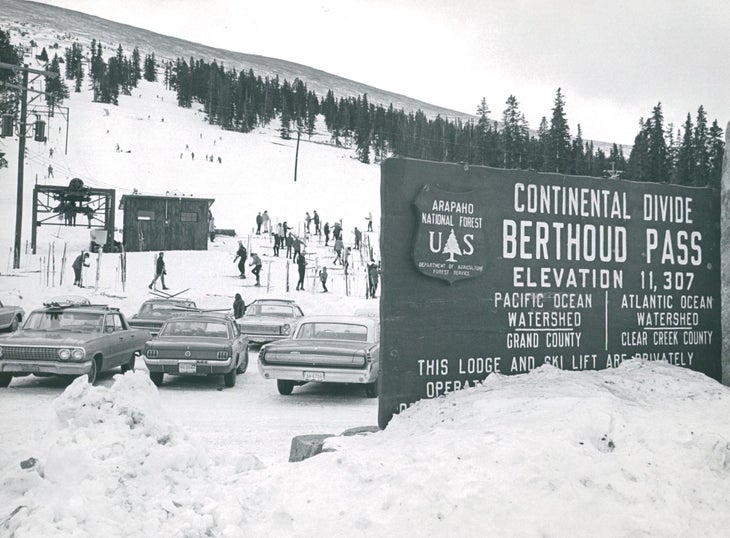Products You May Like
There’s something slightly creepy yet eerily beautiful about abandoned ski areas—decrepit lifts and broken-down shacks surrounded by clean, pristine powder. There are hundreds of “ghost” ski areas across the country, located in nearly every state where there’s skiing, and while some are in better shape than others, you can usually identify the trails cut into the mountainsides decades ago—and ski them if you’re so inclined.
Go Deeper: 8 Classic Backcountry Routes for Beginners to Experts
Prepare to climb via skins or boot-packing, but the stripped-down experience at these spots is worth the effort. (Keep in mind that you do need backcountry safety equipment and knowledge.) Here’s a list of some of our favorite spots to explore.
7 Abandoned Ski Areas Where You Can Backcountry Ski
Berthoud Pass, Colo.
An hour’s drive west of Denver along the Continental Divide is Berthoud Pass. The mountain pass, which sits at 11,307 feet, was once home to the Berthoud Pass Ski Area, which boasted Colorado’s first two-person chairlift and was one of the first ski areas to welcome snowboarders.

The resort chugged along through the late ‘90s, closing permanently in 2003. But backcountry skiers, undeterred by closed lifts, have continued to take advantage of the defunct resort’s well-established skin tracks and ski runs. The terrain on Berthoud ranges from gentle, wide-open runs to glades and cliffs, all covered in an average of 500 inches of snow a year.
Hogback Mountain, Vt.
Just south of present-day Mount Snow, is the now defunct Hogback Mountain Ski Area. The resort opened in the mid 1940s with a T-bar (advertised as the highest-capacity T-Bar in the East) and eventually, a rope tow. Once the ski area officially closed in 1986, the cleared slopes grew over, deterring backcountry skiers for decades.
That all changed when the land was bought by a group of locals with a vision to turn the old ski area into a backcountry ski paradise. These days, the slopes have been cleared and the terrain is once again drawing skiers who come to ski the resort’s original ski runs and explore the trails that traverse Hogback Mountain.
We’re very excited to share a teaser of our interview with Jeremy Davis from New England and Northeast Lost Ski Areas Project – NELSAP.org about the history of Hogback Mountain. Be sure to give us a follow for more content and updates on when the series will be released!
Posted by The Last Chair – Series on Monday, March 8, 2021
Iron Mountain, Calif.
Just off California’s Carson Pass Highway, not far from Kirkwood Mountain Resort, is an inconspicuous and now-closed ski area known as Iron Mountain (formerly Silver Basin Ski Area). Even though the resort offered 1,700 acres of terrain and five lifts in its heyday, it faced a string of financial problems, leading to its closure less than 30 years after it opened in 1970.
These days, that terrain is well utilized by backcountry skiers (as well as cross-country skiers and snowmobilers) who come to ski the area’s 1,200 feet of elevation gain … from the top down. That’s right—at Iron Mountain, you park at the top and ski down. So make sure you save some energy for the long skin back up.
Hidden Valley, Colo.
Long before Hidden Valley became a resort, the ski spot, which sits within Rocky Mountain National Park, was a popular destination for backcountry skiers. In the 1930s, the National Park Service would plow the 48-mile Trail Ridge Road and old army trucks would shuttle skiers to the top. The valley’s popularity led to the opening of Hidden Valley Ski Area in 1955 — but when the ski area closed in 1991, Hidden Valley came full circle, returning to its former role as an unofficial backcountry ski spot.

These days, there are no operational lifts (or army truck shuttles), but the valley’s beloved low-angle slopes and powder stashes remain.
White Grass, W. Va.
When you think of skiing, chances are West Virginia doesn’t come to mind. But the state has its own ski culture, part of which revolves around White Grass, formerly known as Weiss Knob Ski Area. The shuttered resort is now the launchpad for skiers—both cross-country and backcountry—who come to explore the 2,500 acres of terrain and 1,200 vertical feet.
Just keep in mind that this ski spot is more developed than others on this list. There’s a $25 area use fee, a café, a backcountry ski shop, and a lodge.
Marshall Mountain, Mont.
There’s something special about a ski area that was developed with the local community in mind, and Marshall Mountain, just outside Missoula, is one such ski area. The family-friendly mountain started with a basic rope tow in 1937 and was a local go-to before a lack of snow led to its closure in 2002.
These days, old ski runs are criss-crossed with mountain bike trails—the mountain park’s main draw—but backcountry skiing lives on. The park has plenty of gladed and open runs, and expert skiers can use the defunct ski area as an access point to terrain around the Rattlesnake Mountains.
Geneva Basin, Colo.
The ghost resort of Geneva Basin Ski Area (originally Indianhead Ski Area) is located on Guanella Pass, a beautiful high-elevation mountain pass west of Denver that tops out at 11,670 feet. These days, long after the ski area closed in 1984, the ski spot is surprisingly quiet considering its proximity to Denver (1.5 hours by car) and annual snowfall of 300 inches.
The backcountry spot has plenty of accessible runs, from wide, low-grade slopes to glades. Just be forewarned that the spirit of Edward Guanella, the son of the mountain pass’ namesake, is said to haunt the area.
